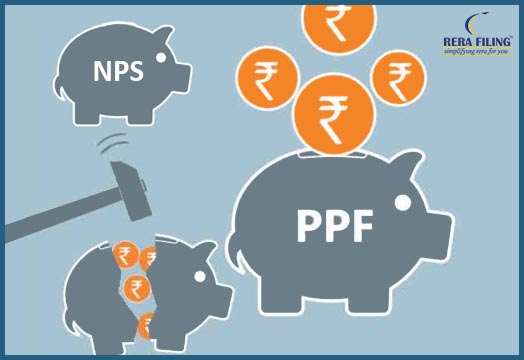NPS v/s PPF, which one is better?

- Wednesday 15th May 2019
- Author: Shreya Uppal
Highlights
The exact rate is set every quarter. Historically rates have fluctuated around 8% per annum. The NPS returns depend on the performance of NPS funds.
On the other hand, over the last few years, a considerable amount of attention has been given to the National Pension System (NPS), a defined contribution retirement savings scheme whose returns are also market-linked.
The balance amount can be placed in NPS Corporate Bond Funds or NPS Government Bond Funds.
Retirement income is a crucial subject. With our work lives becoming shorter but life expectancy rising, the risk of outliving your wealth is very real today. Traditionally, non-government individuals have sought shelter in the evergreen investment scheme known as the Public Provident Fund (PPF). On the other hand, over the last few years, a considerable amount of attention has been given to the National Pension System (NPS), a defined contribution retirement savings scheme whose returns are also market-linked.
What is NPS?
National Pension System (NPS) is a voluntary, defined contribution retirement savings scheme designed to enable the subscribers to make optimum decisions regarding their future through systematic savings during their working life. NPS seeks to inculcate the habit of saving for retirement amongst the citizens. It is an attempt towards finding a sustainable solution to the problem of providing adequate retirement income to every citizen of India.
Eligibility for NPS
A citizen of India, whether resident or non-resident, subject to the following conditions:
(a) Applicant should be between 18 – 60 years of age as on the date of submission of his/her application..
(b) Applicant should comply with the Know Your Customer (KYC) norms as detailed in the Subscriber Registration Form.
(c) All the documents required for KYC compliance need to be mandatorily submitted.
What is PPF?
PPF is an age-old government-funded investment scheme that has been popular among investors with a long investment horizon. For best results, one needs to stay invested in the scheme for 15 years! Earlier, there was no provision for premature closing of the PPF account but this feature has been added now with the caveat that the account holder keeps the PPF account active for a minimum of 5 years before closing it. The premature closing will only be allowed under certain circumstances like paying for one’s higher education, for medical expenses (in case of life-threatening diseases and supported by documents from a medical practitioner).
Eligibility for PPF
Any Indian citizen can invest in PPF. One citizen can have only one PPF account unless the second account is in the name of a minor. NRIs and HUFs are not eligible to open a PPF account.
Recently the Indian government, in a bid to make NPS more friendly, gave complete tax exemption to 60% of the corpus that investor can withdraw on maturity. A little while ago, NPS partial withdrawal norms and investment allocation rules were also made friendlier. So, is NPS a better product than PPF now? The answer depends on how an investor defines ‘better’. The definition of better varies from case to case.
Comparison between NPS and PPF
|
Criteria |
PPF |
NPS |
|
Safety |
High |
Low |
|
Returns |
Moderate |
High |
|
Withdrawal Tax |
100% tax free |
Exempted subject to various conditions |
|
Equity Investment Freedom |
15% of equity exposure and rest remains fixed-income oriented investment. |
Equity exposure of 75% |
|
Liquidity |
Low |
Low |
1. Safety
The NPS is not a fixed return instrument and is less safe in that sense. In a broader sense however, it is tightly regulated by the PFRDA (Pension Fund Regulatory and Development Authority) and is not likely to face large challenges from fraud/malpractice. The NPS returns depend on the performance of Pension Fund Managers and one can change managers if he is not satisfied with the performance of the manager. The PPF has fixed returns which are set by the Government. The PPF money is utilised by the government as well. As a result it carries almost no risk of default.
2. Returns
The PPF has a fixed return rate. The exact rate is set every quarter. Historically rates have fluctuated around 8% per annum. The NPS returns depend on the performance of NPS funds. An NPS allows a maximum of 75% allocation to equity due to high risk factor providing higher returns than PPF. The balance amount can be placed in NPS Corporate Bond Funds or NPS Government Bond Funds.
3. Withdrawal Tax
The maturity amount of PPF one gets is 100% tax-free. This is a big draw for investors looking for tax-free income. The entire money after maturity is tax-free. There is no compulsion on what one should do with the maturity amount.
In the case of NPS, the government has approved a proposal to make NPS fully tax-free on withdrawal. This means NPS subscribers will get full tax exemption on the 60% of the corpus that an investor is allowed to withdraw on maturity. The rest 40% (which is also tax-exempt), like previously, has to be invested in annuity plans for getting regular pension payouts. An important point to be kept in mind is that the balance 40% amount has to be mandatorily used for purchasing an annuity.
4. Equity Investment Freedom
The returns of PPF are market-linked. However, this does not mean a subscriber has full say in where the funds would be invested. PPF subscribers are allowed to have up to 15% of equity exposure and PPF remains a fixed-income oriented investment avenue. In case of NPS, subscribers enjoy a lot more freedom. Since August 31, 2018, private sector NPS subscribers have been able to opt for a maximum equity exposure of 75% under the active choice option (where the subscriber actively decides where his contribution is to be invested).
5. Liquidity
In case of PPF, the account can be closed prematurely before 15 years but only under specific conditions. A PPF subscriber can prematurely close the scheme after completing 5 years for specific reasons such as higher education or expenditure towards medical treatment. There is a penalty for premature closure of the account i.e. a subscriber will get 1% less interest. Starting from the 7th year, a PPF account holder can make one partial withdrawal per year. The withdrawal is limited to 50% of the total balance at the end of the 4th year immediately preceding the year of withdrawal, or the year immediately preceding the year of withdrawal (whichever is lower).
The government has allowed premature withdrawal from NPS. Subscriber should be in NPS at least for 3 years. The withdrawal amount will not exceed 25% of the contributions made by the subscriber. Withdrawal can happen a maximum of three times during the entire tenure of subscription. Withdrawal is allowed only against the specified reasons like higher education of children, the marriage of children, for the purchase/construction of the residential house (in specified conditions) and for treatment of critical illnesses.
To conclude, we can say that the compulsory annuity purchase requirement in case of NPS maturity is still a disadvantage for those subscribers who want full and unconditional access to tax-free proceeds. In that perspective, PPF is a better avenue. However, the equity investment exposure freedom (up to 75%) and shorter lock-in related to partial withdrawal do give NPS the edge over PPF.
Smart investors should use a combination of NPS and PPF products to build a better-diversified retirement corpus over the long run.
More Articles
- Online Listing Tips for Real Estate Agents
- How to start a Real Estate business in India - a complete guide !
- Renting Vs Buying property - How will you decide?
- What you should do in Property Management services
- Home Loan Insurance
- How to choose your builder?
- How to ensure fire safety in your home!
- Tips To Keep In Mind While Taking A Home On Rent
- Importance of Home Security
- How to plan your property budget?
- Leased vs. Purchased vs. Co-Working Office Spaces
- Easy Tips to Build an Eco Friendly Home
- Sample Flat - A Trick by a Builder?
- How to have a Beautiful Guest Room? Impress your Guests with these Guest Room Ideas..
- Understanding MCLR and its Effects on Home Loans
- 5 simple ways to close a real estate deal
- Is it worth to buy property near an airport ?
- Home loan tax benefit
- How to be successful in business as an introvert
- Cost effective home decor ideas
- What to Be-Paying Guest or a Tenant??
- Complete guide to start your small business
- Sports township- New trend in India
- Online Listing Tips for Real Estate Agents
- Understanding Floor Area Ratio- FAR
- Town and Country Planning | Meaning and Importance
- Checklist of Important Property Documents- All You Need to Know
- Role of CREDAI in real estate
Copyright © 2023 RERA Filing. All rights reserved.
 Rera
Act
Rera
Act
 Maharashtra
Maharashtra Karnataka
Karnataka Andhra Pradesh
Andhra Pradesh Uttar Pradesh
Uttar Pradesh